Search the Blog
Categories
- Books & Reading
- Broadband Buzz
- Census
- Education & Training
- General
- Grants
- Information Resources
- Library Management
- Nebraska Center for the Book
- Nebraska Memories
- Now hiring @ your library
- Preservation
- Pretty Sweet Tech
- Programming
- Public Library Boards of Trustees
- Public Relations
- Talking Book & Braille Service (TBBS)
- Technology
- Uncategorized
- What's Up Doc / Govdocs
- Youth Services
Archives
Subscribe
Author Archives: Sam Shaw
2019 Public Library Survey Data is Now Available
 The 2019 FY public library survey data is now available on the NLC website. This is preliminary data (meaning that it has not yet been certified by IMLS) so keep in mind that it is subject to change. Thanks to all of you who submitted your statistics. Historical data (back to 1999) is also available on our website. The next survey cycle begins in November, but you should be collecting those statistics now. If you are a new library director, check out the Bibliostat guide.
The 2019 FY public library survey data is now available on the NLC website. This is preliminary data (meaning that it has not yet been certified by IMLS) so keep in mind that it is subject to change. Thanks to all of you who submitted your statistics. Historical data (back to 1999) is also available on our website. The next survey cycle begins in November, but you should be collecting those statistics now. If you are a new library director, check out the Bibliostat guide.
Friday Reads: The Beautiful Ones

Intro: With all the unrest in the nation that started in the Minneapolis area, I thought it appropriate to post this FR. Years ago, I had a high school friend who moved to Chanhassen, Minnesota (just south of the Twin Cities), where Paisley Park is. I visited my friend a few times in Chanhassen, and quickly realized January was not a good time. Summers were nice, though. Sadly, my friend has passed away (cancer). He never saw his 26th birthday.
Opening: Yep, it is another music biography. I have a sort of love and hate relationship with music biographies, but this one is well done and I recommend it. A few years ago, I was in the Minneapolis area (after the death of Prince) and thought of touring Paisley Park. I decided against it because I did not think that Prince would have wanted visitors that way. However, I completely understand the estate’s decision to do so. By not opening it up, there’s no way it would sustainable. Musical biographies can be quite a hit or miss, but often are a miss due to the fact they come across as braggadocios. Prince certainly seemed like the antithesis of that.
Background Info: Before he died, Prince was working on this book, with the help of Dan Piepenbring. The intro was written by Dan, summarizing his first meetings with Prince, and Prince’s vision for the completed work (he intended for it to cover his childhood up to his performance at Super Bowl XLI (in 2007). Dan’s anecdotes provide an interesting segue into the actual writing of Prince, and the numerous photos published in this book. The stories, including Dan staying at the local Country Inn and Suites (the place closest to Paisley Park in Chanhassen, MN), Prince driving him around in his Lincoln MKT, and live performances at Paisley Park.
Filler Material: The bulk of the middle part consists of Prince’s actual writings, and then the translations. His writings are hard to read, given his affinity for code (e.g. eye symbol for I) and handwriting. The gist of the book, and hats off to the publishers, was not to fill in the chronology after where Prince was at with his writing. Therefore, there is no speculation about his thoughts, as the material is published just as he wrote it, and stops at the point where he was at when he passed (before the Super Bowl XLI performance). As a companion piece, Originals (on CD, vinyl, MP3, take your pick) published after his death, is highly recommended. Toss it on the old (dust off the console stereo) or new hi-fi and turn up the volume.
Killer Ending: “So much has been written about me, and people don’t know what’s right and what’s wrong. I’d rather let them stay confused.” – Prince
Prince. The Beautiful Ones. Spiegel & Grau, 2019.
Results From COVID/Cares Act Survey
 As of this week, we have received 163 responses to the COVID/Cares Act survey sent to libraries, representing a 65% response rate. The input of libraries has been valuable to NLC planning for Cares Act funding. Stay tuned for more information about that, but for now, it might be helpful to summarize the survey results.
As of this week, we have received 163 responses to the COVID/Cares Act survey sent to libraries, representing a 65% response rate. The input of libraries has been valuable to NLC planning for Cares Act funding. Stay tuned for more information about that, but for now, it might be helpful to summarize the survey results.
The survey asked what libraries are doing to prepare for re-opening, and what the concerns are upon re-opening. This bar chart at the top illustrates the results, and note that libraries could choose more than one response. Cleaning, handling of materials, and programming topped the list. However, it is important to note that many libraries are concerned about the proximity of patrons in various areas of the library (e.g. meeting rooms, computer labs, etc.). Some noted a potential shift when re-opening to provide extended computer lab hours in order to accommodate needs, or providing more mobile devices for check out (inside or outside of the library) in order to provide social distance.
As far as staffing goes, we know that some libraries have experienced RIF’s (reduction in force), and layoffs, but this has not been the norm. Over 30% of respondents reported all staff reporting to work, and over 30% reported at least the director reporting to work. It is appropriate to note that many libraries only have one primary staff person (the director). Only 6% reported that no staff were coming to work. Numerous libraries are offering alternative services, as over 75% reported providing curbside circulations and over 40% reported providing virtual programming. 90% of survey respondents reported completing tasks associated with circulation and mail processing. This likely includes cleaning and quarantining items, and almost 75% reported maintenance, security, and cleaning tasks performed by staff.
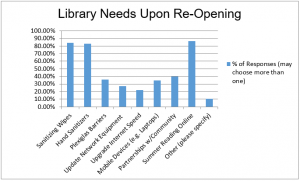 The survey also asked about what the library’s needs are upon re-opening. Topping the list is an alternative to in-person summer reading events, and making sure items are clean and safe by providing adequate sanitizing and protective equipment. This chart at the right shows those results.
The survey also asked about what the library’s needs are upon re-opening. Topping the list is an alternative to in-person summer reading events, and making sure items are clean and safe by providing adequate sanitizing and protective equipment. This chart at the right shows those results.
Finally, some of the open-ended answers give insight into longer-term needs of libraries to address community concerns and prepare for the future. Anecdotally, some of these responses include the following:
- Expanding the range of Wi-Fi to areas outside of the library, allowing for users to be more spread out;
- Device lending to community members that do not have their own (e.g. laptop, tablet computers);
- Providing relevant information about COVID-19 to the community;
- Online/virtual programming;
- eBook and Audiobook availability and access;
- Providing materials (clean and sanitized) such as books, puzzles, music, videos, games, and activity packs to quarantined or at risk groups;
- Improve internet speed and infrastructure to handle increased demands;
- Printing, copy, and fax services (providing with lower touch);
- Reference and partnerships with organizations to support unemployment, economic recovery, small business, and other assistance; and
- Hotspot lending.
Many libraries are now evaluating their technology, network infrastructure, and Wi-Fi (range, speed, etc.). Did you know that NLC offers FREE technology assessments and help to you? If you are interested, please check out our Better Broadband webpage for resources, and to move forward towards an assessment, contact ,Holly Woldt.
Posted in General, Library Management, Public Relations, Technology
Leave a comment
OverDrive Data
For today, we are looking at some data as it relates to libraries offering alternative services during the COVID-19 crisis. Specifically, we are looking at a potential shift to electronic resources, in this case, OverDrive. But first, I want to provide a link to the fantastic data that is being put out by the Nebraska Department of Labor. From the DOL main page, I was looking mostly under their resources, then INFOLink pages, for raw data about unemployment statistics and claims. Next, I found their visualizations, which are excellent, and detail unemployment claims by county with maps, and some very illustrative charts. If you have a chance, visit their visualizations HERE.
Now, to OverDrive. From my colleague here at NLC, I got some data about new OverDrive users, and OverDrive circulations. I was curious to see if there was a correlation between new users and circulations as many libraries shut down operations or offered modified services, such as curbside pickups. The first graphic illustrates libraries with new OverDrive users, and the total number of new users, for the weeks beginning in January, 2020:
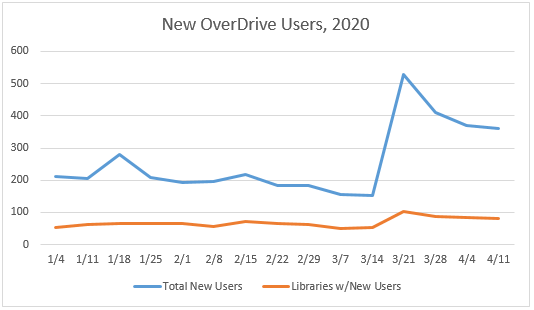
As the chart illustrates, there was a spike during the week of March 14 – 21, then a leveling off. Next, I looked at OverDrive circulations, and you guessed it, they increased:
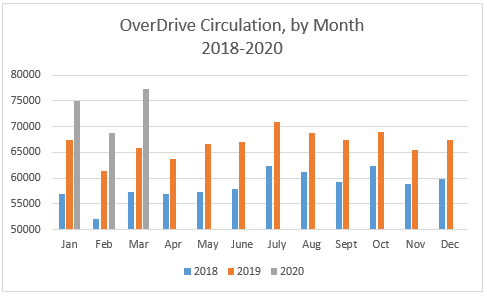
But wait. There’s more to this chart. For this one, I visualized the data from the previous 2 years, 2018 and 2019. If we look at March, we see the large spike in OverDrive circulations from 2019 to 2020, but it helps to put this in perspective. Between March, 2018 and March, 2019, circulations increased at a rate of 15.07%. From March, 2019 to March, 2020, circulations increased at a rate of 17.33%. So a slightly higher percentage of circulation growth compared to the prior year. For February, the 18-19 increase (17.98%) was higher than the 19-20 increase (12.15%). April data might be the telling point to look at, and I intend to post about that when it becomes available.
2020 State Aid Information Has Been Posted
 The 2020 state aid calculations are now complete. This year, we’ve transitioned from paper state aid letters to electronic distribution of information to public libraries. You should have received an e-mail notification about your aid if you are an accredited public library. Here is some general information about the state aid program and eligibility, and how it is distributed. There is also a posted list of the state aid distributions for 2020 (including this year’s formula, the payment amounts, and aid per capita). Finally, here is a link to a press release you can customize and use for your particular library.
The 2020 state aid calculations are now complete. This year, we’ve transitioned from paper state aid letters to electronic distribution of information to public libraries. You should have received an e-mail notification about your aid if you are an accredited public library. Here is some general information about the state aid program and eligibility, and how it is distributed. There is also a posted list of the state aid distributions for 2020 (including this year’s formula, the payment amounts, and aid per capita). Finally, here is a link to a press release you can customize and use for your particular library.
This year, there were 46 libraries that will be receiving Dollar$ for Data payments. Those libraries are now eligible to apply for accreditation.
The next public library survey collection cycle (required to maintain accreditation for accredited libraries and required for unaccredited libraries to receive Dollar$ for Data payments) begins in November.
Posted in General, Library Management, Public Relations
Leave a comment
COVID-19 Data and Maps
As a result of COVID-19, we are collecting data about library closures, modified schedules, and alternative services. For updates to your schedule, submit this form. The data is available here.
Additionally, we are updating maps with this data (every few days).
Nebraska Libraries With Modified Services
Nebraska Libraries Offering Wi-Fi During Closures
Finally, there are some questions about collecting data and statistics for the next public library survey. Undoubtedly, there will be declines in some numbers (visits) and likely increases in others (electronic circulation). One common question thus far is how to count online or virtual programs. If the online program is a planned event, then you count it as a regular in-person program. Count everyone in virtual attendance. If other services are offered remotely, those might be counted as reference transactions, depending on the nature of the Q&A.
Posted in General, Information Resources, Library Management
Tagged coronavirus, covid-19, pandemic, wash your hands
Leave a comment
Friday Reads: The Last Castle: The Epic Story of Love, Loss, and American Royalty in the Nation’s Largest Home
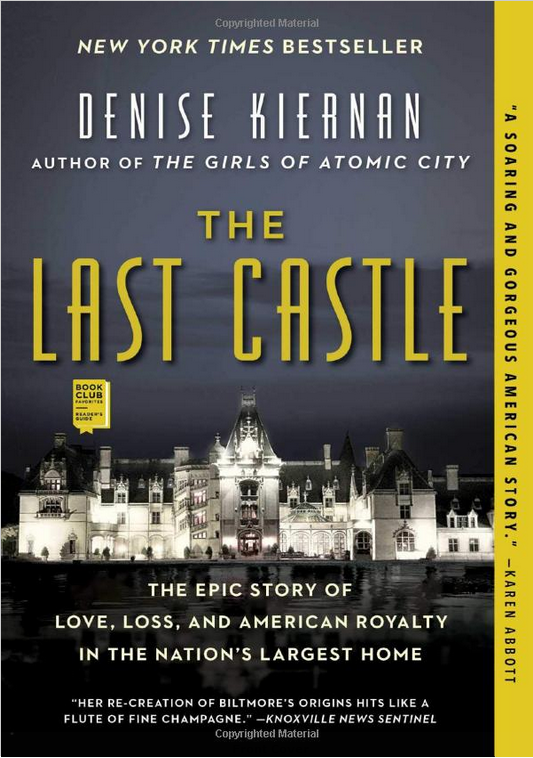
In addition to the history of the Biltmore estate, this book also covers the Vanderbilt family. After a bit of background into the wealth inherited by George Washington Vanderbilt, the youngest son of William Henry “Billy” Vanderbit, the book focuses its attention mostly on the life of George, the building of the Biltmore estate, his wife, Edith Dresser, and the chronology of their lives and the evolution of the Biltmore estate. The Vanderbilt wealth was expanded through railroads and shipping and increased through inheritances. In 1877, Billy inherited nearly $100 million from his father, and when he died in 1885, his wealth had doubled to over $200 million. George was the youngest son of Billy, with seven siblings. Being the youngest, his inheritance was less than his siblings, although still in the millions of dollars. George was an eccentric cat, introverted with interests in art and books. Longtime bachelor until his marriage to Edith at age 37. In many ways, the book is also about Edith and her relationship with the Biltmore, especially since George died at the age of 51.
At any rate, the book covers interesting background information about the Vanderbilts, their fortune, philanthropy, and super-rich lifestyles. The book details George’s vision for the Biltmore, and its construction and maintenance. The estate was built from 1889 to 1895. Some of the statistics are staggering; especially considering this was pre-1900:
- A woodworking factory and brick kiln was produced on site, generating 32,000 bricks per day;
- 175,000 total square feet, with more than 4 acres of floor space;
- 250 rooms in the house, including 35 guest rooms, 43 bathrooms, 65 fireplaces, and 3 kitchens;
- Over 100,000 acres of surrounding area, including a robust forestry program (after George’s death Edith sold over 85,000 acres back to the federal government); and
- A library with over 10,000 volumes, many rare and collectible.
The Biltmore has been open to the public since 1930, with a brief hiatus during World War II, when various paintings and sculptures were moved there from the National Gallery of Art to protect them in the event of an attack on the U.S. The home continues to be owned by a private company ran by the Vanderbilt heirs. The Last Castle is overall an interesting read, not only pertaining to the construction and maintenance of the Biltmore estate, but also the Vanderbilt family and surrounding Asheville community.
Kiernan, Denise. The Last Castle: The Epic Story of Love, Loss, and American Royalty in the Nation’s largest Home. Atria Books, 2017.
The Public Library Survey Deadline is Approaching
 The deadline for submitting the public library survey on Bibliostat is approaching fast. Surveys need to be submitted by February 14, 2020.
The deadline for submitting the public library survey on Bibliostat is approaching fast. Surveys need to be submitted by February 14, 2020.
Here is the link to the survey. There is also a training guide on our website. If you need your password, or have questions about the survey, feel free to contact me. You can also enter your e-mail in the lost password part of our website.
For other guides, and copies of the survey you can review or print before entering your data into Bibliostat, check out the main Bibliostat page on our website.
I am here to help you with the survey. Feel free to contact me with any questions.
Posted in General, Library Management
Leave a comment
Broadband Facts for Your County

Is your community wanting to work to improve the broadband speed in your library? Often times, library speeds lag behind what the community really needs, or the community might not understand how impactful improving the library internet might be. Sometimes, it is difficult to even determine what your community needs might be. One first step in having these conversations is to look over our now available broadband fact sheets. These are available for every county in Nebraska, and are intended to be used to help start community, county-wide or regional discussions about broadband availability, adoption, and digital inclusion. More information, including data sources and suggested discussion questions are also included. To view or download these, go to the main broadband page on the data services portion of our website. From there, you have the option to select by county, or pull up a map and click on a county for the fact sheets. The main page also has a broadband discussion guide, to help you with these conversations.
Friday Reads: Live Young Forever
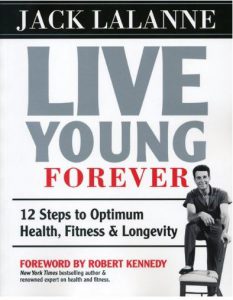
What I was really looking for was a biography about Jack LaLanne, but unfortunately, I was not able to find any. The next closest thing (although I later found out there was a documentary film made about Jack, called Anything is Possible, but only about 39 minutes in length) was Live Young Forever, which did just fine and it was written by Jack himself. How did I get to the point of seeking out this book? Well, for one I never learned of Jack’s world famous feats until years after they occurred, having mostly known him for his juicer infomercials that aired when I was a kid after the Saturday cartoons. Jack’s exercise show was before my time. I remember him as the old health nut in the jumpsuit hawking juicing machines. Then recently, I clicked PBS on and got intrigued by the documentary called Fat, Sick, and Nearly Dead. The documentary follows Australian entrepreneur, author, and filmmaker Joe Cross across the U.S., as he went on a 60-day journey of consuming only juices from fresh fruits and vegetables. While Jack advocated healthy doses of exercise, juice, fish, fruits, and vegetables, Joe’s condition (he weighed over 300 pounds and had a host of health conditions) necessitated a juice only “fast” to kick start his health. Then I realized I’d unfortunately (for me) sold my mom’s Jack LaLanne juicer at a garage sale for $10, so it was off to find another.
Back to Jack. For anyone looking to live a healthier lifestyle, this book has quite a few essential elements such as diet, exercise, and motivation. However, it was Jack’s personal stories that I liked the best. Aside from his health advocacy and TV show, this book also contains numerous stories of his famous feats. Such as a 21-year old Arnold Schwarzenegger, who in 1968 came to Venice beach in California and witnessed a 54-year old LaLanne doing chin-ups and push-ups. Arnold declared a challenge, and lost badly to LaLanne. Said Arnold: “That Jack LaLanne’s an animal! I was sore for four days. I couldn’t lift my arms.” Some of Jack’s other feats included:
- 1955 (age 41) swam from Alcatraz Island to Fisherman’s Wharf, while handcuffed;
- 1956 (age 42) set a claimed world record of 1,033 push-ups in 23 minutes;
- 1959 (age 45) did 1,000 jumping jacks and 1,000 chin-ups in 1 hour, 22 minutes;
- 1974 (age 60) swam the same Alcatraz to Fisherman’s Wharf route, handcuffed, shackled at the ankles, and towing a 1,000 lb boat;
- 1976 (age 62) swam one mile in Long Beach Harbor, handcuffed and shackled, towing 13 boats to represent the original 13 colonies, and containing 76 people; and
- 1984 (age 70) swam 1 mile in Long Beach Harbor, handcuffed and shackled, towing 70 rowboats containing various guests.
Finally, my favorite Jack LaLanne quote:
“15 minutes to warm up? Does a lion warm up when he’s hungry? ‘Uh oh, here comes an antelope. Better warm up.’ No! He just goes out there and eats that sucker.”
The Public Library Survey is Now Available
 The public library survey is now available on Bibliostat. The survey is open for data collection from today (November 4, 2019) thru February 14, 2020, and covers the 2018-2019 fiscal year (typically either July 1, 2018 – June 30, 2019 or October 1, 2018 – September 30, 2019).
The public library survey is now available on Bibliostat. The survey is open for data collection from today (November 4, 2019) thru February 14, 2020, and covers the 2018-2019 fiscal year (typically either July 1, 2018 – June 30, 2019 or October 1, 2018 – September 30, 2019).
Here is the link to the survey. There is also a training guide on our website. If you need your password, or have questions about the survey, feel free to contact me. You can also enter your e-mail in the lost password part of our website.
For other guides, and copies of the survey you can review or print before entering your data into Bibliostat, check out the main Bibliostat page on our website.
I am here to help you with the survey. Feel free to contact me with any questions.
Posted in General, Library Management
Leave a comment
E-rate @ West Point
Have you registered for the upcoming E-rate workshops? In person workshops are still open for Grand Island (October 28), and Ashland (November 12). Registration information can be found here:
Don’t worry if you miss (the workshop that is), as you can always register or view the online session. It’s the E-rate you don’t want to miss out on. You can also make it a full day and attend the afternoon Digital World session. For more information about the impact of E-rate, check out this week’s Adobe Spark video. Like the others, this was created using all free resources. This week’s story is from the John Stahl Public Library in West Point:
[youtube https://www.youtube.com/watch?v=bVLf0S283Z8&w=560&h=315]E-rate Story
Special thanks to those public librarians who recently completed our technology and E-rate survey. As of today, we have received over 200 responses. While we are working on analyzing the results, here’s a little 2 minute video (see below), with special thanks to the Pawnee City Public Library. FREE tools were used to create this video using Adobe Spark. If you are interested in learning more about E-rate, consider attending one of the upcoming workshops:
October 21, 2019 – Columbus (Central Community College)
October 28, 2019 – Grand Island Public Library
November 5 – Online via GoToWebinar
The video has sound, so make sure to turn yours on. Here you go:
[youtube https://www.youtube.com/watch?v=tZr3hWzA3ME&w=560&h=315]
Technology and E-rate Survey

NLC is currently collecting data from Nebraska public libraries regarding technology and E-rate. If you have not yet responded to the survey, please take a few minutes (it should take around 5 minutes to complete) to submit your survey response. Your input is essential. Here is a link to the survey:
Posted in General, Library Management, Technology, Uncategorized
Leave a comment
Friday Reads: Dog Man: Unleashed
 In keeping with the tradition of, er, I mean, my tradition of, lowbrow reading, this week’s installment is a little write up about Dog Man Unleashed. While the intended audience here is definitely grades 2+, uncultured readers of any age will enjoy the originality of this story. Dog Man Unleashed is the second installment in Dav Pilkey’s Dog Man series. The Dog Man series tells the post-accident stories of Dog Man (of course), a surgical union of a police officer and his sidekick police dog, Greg. An explosion resulted in injuries to both, so to save them, a surgeon sewed Greg’s dog head onto the human police officer’s body, resulting in (you guessed it), Dog Man.
In keeping with the tradition of, er, I mean, my tradition of, lowbrow reading, this week’s installment is a little write up about Dog Man Unleashed. While the intended audience here is definitely grades 2+, uncultured readers of any age will enjoy the originality of this story. Dog Man Unleashed is the second installment in Dav Pilkey’s Dog Man series. The Dog Man series tells the post-accident stories of Dog Man (of course), a surgical union of a police officer and his sidekick police dog, Greg. An explosion resulted in injuries to both, so to save them, a surgeon sewed Greg’s dog head onto the human police officer’s body, resulting in (you guessed it), Dog Man.
The writing appeals to younger reluctant readers and often isn’t grammatically correct (e.g. Super is “Supra”, and Laughs are “Laffs”), but who cares? You aren’t reading this for the highbrow storyline, you read it for the cartoonish illustrations and over the top tangents. And let’s face it, some educators need to lighten up a little bit and not worry about all these details. The antagonist Petey the cat (not to be confused with Pete the Cat), is the recurring up to no good villain who also appears in a couple of the Captain Underpants books, and has multiple schemes throughout the Dog Man Series. This installment (Dog Man Unleashed), while simplistic (Dog Man working to save the city from the evil, up to no good Petey), is effective in that it ultimately demonstrates kindness, empathy, friendship, teamwork, etc. However, the side stories, such as Dog Man tracking things with his smell, chasing cars, and hiding bones are equally entertaining. That and the simplistic illustrations will surely give the reader some welcome laffs.
One final note on those that express displeasure with the grammatical incorrectness of this book. Let me say that we often are caught up in rigidity at the expense of art and creativity. And (yep, I’m starting a sentence with And), that is evidence of one’s missing out on truly imaginative and unique things.
Pilkey, Dav. Dog Man Unleashed. Graphix (2016).
Preliminary 2018 Public Library Survey Data is Now Available
 The 2018 public library survey data is now available on the NLC website. This is preliminary data (meaning that it has not yet been certified by IMLS) so keep in mind that it is subject to change. Thanks to all of you who submitted your statistics. Historical data (back to 1999) is also available on our website. The next survey cycle begins in November, but you should be collecting those statistics now. If you are a new library director, check out the Bibliostat guide.
The 2018 public library survey data is now available on the NLC website. This is preliminary data (meaning that it has not yet been certified by IMLS) so keep in mind that it is subject to change. Thanks to all of you who submitted your statistics. Historical data (back to 1999) is also available on our website. The next survey cycle begins in November, but you should be collecting those statistics now. If you are a new library director, check out the Bibliostat guide.
2019 State Aid Letters Have Been Mailed
 The 2019 state aid calculations are now complete. State aid letters have been mailed and payments will be processed soon. In the meantime, you can read (in general) about state aid and how it is distributed. Here is a list of the state aid distributions for 2019 (including this year’s formula). Finally, here is a link to a press release you can customize and use for your particular library.
The 2019 state aid calculations are now complete. State aid letters have been mailed and payments will be processed soon. In the meantime, you can read (in general) about state aid and how it is distributed. Here is a list of the state aid distributions for 2019 (including this year’s formula). Finally, here is a link to a press release you can customize and use for your particular library.
This year, there were 47 libraries that will be receiving Dollar$ for Data payments. For those libraries, you are now eligible to apply for accreditation when the cycle opens this summer.
For libraries that aren’t accredited, now may be the time to consider the accreditation process, as you would then be eligible for state aid next year. You also need to submit your public library survey online via Bibliostat. The next public library survey collection cycle begins in November.
Posted in General, Library Management, Public Relations
Leave a comment
Friday Reads: Stoner
 This book is a bit of false advertising, as it is nothing like the title suggests. Nevertheless, I did stick with it, after learning that Stoner actually is a reference to William Stoner, the main character in the novel by John Williams (1922-1994). The book was originally published in 1965. Stoner tells the story of William, born and raised on a small farm in Missouri, who eventually goes off to Columbia, MO to college. The original plan is for Stoner to complete a degree in agriculture, and then return to implement his knowledge for the benefit of the family farm. However, while in Columbia, Stoner develops an interest in literature, eventually earning his Ph.D. and subsequently teaching at the University in Columbia. While Stoner tells the semi-interesting story of his lackluster marriage, his relationship with his daughter, and life teaching English (including faculty relationships and conflicts), it is really more about his stoicism.
This book is a bit of false advertising, as it is nothing like the title suggests. Nevertheless, I did stick with it, after learning that Stoner actually is a reference to William Stoner, the main character in the novel by John Williams (1922-1994). The book was originally published in 1965. Stoner tells the story of William, born and raised on a small farm in Missouri, who eventually goes off to Columbia, MO to college. The original plan is for Stoner to complete a degree in agriculture, and then return to implement his knowledge for the benefit of the family farm. However, while in Columbia, Stoner develops an interest in literature, eventually earning his Ph.D. and subsequently teaching at the University in Columbia. While Stoner tells the semi-interesting story of his lackluster marriage, his relationship with his daughter, and life teaching English (including faculty relationships and conflicts), it is really more about his stoicism.
After reading more about stoicism, it sounds great in theory, but after reading Stoner I’m not buying what the stoics are selling. For some filler material, I also read a bit of the well-known stoic and Roman emperor Marcus Aurelius (121 – 180 AD), whose book Meditations is a mix of hell yes (“The more we value things outside our control, the less control we have”) and fortune cookie philosophy (“The best revenge is not to be like your enemy”). I dunno, sometimes it seems as though revenge along the style of Ray Donovan or Donnie Yen seems appropriate. Depends on the circumstances I suppose. OK – back to the stoics. Generally speaking, the stoic endures hardship or pain without feelings or complaint, and this is exactly the life of Stoner, sans a few very brief moments of joy and happiness. However, after reading Stoner I realized something I had not thought of before or maybe did not see. And that is that the stoic life seems to not only suffer through hardships without complaint (dispassionate), but to also be void of any passion. Let’s face it — sometimes I like to be passionate about the fact that I’m dispassionate about certain things. And that I think is where Stoner falls short, at least on a philosophical level. On a literary level, it’s an OK read, but man you really come away thinking that Stoner is a real sad sack.
Williams, John. Stoner. NYRB Classics, 2006.
Public Library Survey Deadline Friday February 15, 2019
 The deadline for the annual (2017-2018 fiscal year) IMLS public library survey (submitted via Bibliostat) is Friday, February 15, 2019. Completion of the survey is required for your library to receive state aid if you are accredited. If you aren’t accredited, you still have an incentive to complete the survey ($200), called Dollar$ for Data.
The deadline for the annual (2017-2018 fiscal year) IMLS public library survey (submitted via Bibliostat) is Friday, February 15, 2019. Completion of the survey is required for your library to receive state aid if you are accredited. If you aren’t accredited, you still have an incentive to complete the survey ($200), called Dollar$ for Data.
Please feel free to contact me if you have any questions throughout the process. Thank you in advance for your participation.
Posted in General, Library Management
Leave a comment
Friday Reads: The Wrecking Crew: The Inside Story of Rock and Roll’s Best-Kept Secret
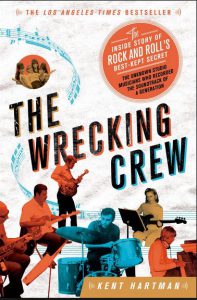 A little while ago, I had just finished reading The Wrecking Crew: The Inside Story of Rock and Roll’s Best-Kept Secret and I was listening to a story on NPR about music students attending the Berklee College of Music in Boston. Ironically, the story highlighted current student musicians that were contributing to the music world in a way quite similar to the wrecking crew of the 1960’s and 1970’s. You see, the original wrecking crew was a collection of backup (or maybe background would be a more appropriate word) musicians that played on numerous studio recordings. Like the Berklee music students, the wrecking crew played on jingles, theme songs, film scores, and commercials (the Berklee students have expanded to playing music for podcasts, video games, and other things).
A little while ago, I had just finished reading The Wrecking Crew: The Inside Story of Rock and Roll’s Best-Kept Secret and I was listening to a story on NPR about music students attending the Berklee College of Music in Boston. Ironically, the story highlighted current student musicians that were contributing to the music world in a way quite similar to the wrecking crew of the 1960’s and 1970’s. You see, the original wrecking crew was a collection of backup (or maybe background would be a more appropriate word) musicians that played on numerous studio recordings. Like the Berklee music students, the wrecking crew played on jingles, theme songs, film scores, and commercials (the Berklee students have expanded to playing music for podcasts, video games, and other things).
So The Wrecking Crew documents the lives of these studio musicians, how they started and expanded in the business, and their interactions with some of the writers, producers, arrangers, and other notable artists. These include, among others, Brian Wilson, Sonny and Cher, Simon and Garfunkel, John Lennon, Frank Sinatra, and the Mamas and the Papas. While one of the more well-known members of the crew was Glen Campbell (who also toured as one of the Beach Boys), the book also focuses on drummer Hal Blaine and guitarist Carol Kaye (shown here hilariously giving Gene Simmons a lesson on bass). Incidentally, the name wrecking crew, penned by Hal Blaine, is disputed by Carol Kaye, who mentions that the group of musicians weren’t generally known as such (but sometimes called “the Clique”). Call them whatever you choose, but this set of musicians were the go-to’s when it came to studio recording, and the point is that the work was good enough for them to earn a living doing it. Most of the recorded music you hear from this time has these musicians playing on it instead of the actual bands that toured. And the kicker is that you would never know it; most of the time (if not all of the time) they weren’t credited.
The book also offers an interesting insight into many of the colorful (both in a healthy creative way and sometimes controlling and abrasive) characters in the music world at the time. For the creative but meticulous, think Brian Wilson. For the controlling and abrasive (and sometimes downright crazy), think Phil Spector. The Wrecking Crew offers access into not only these major artists but also those behind the scenes. A documentary film about the Crew, based on the book, may also be of interest (some of the original footage illustrates things in a worthwhile way).
Hartman, Kent (2013). The Wrecking Crew: The Inside Story of Rock and Roll’s Best-Kept Secret. St. Martin’s Griffin.


